In our previous Data Insight from back in June 2018, we took a brief look into to the relationship between to the two core components of traditional portfolios, U.S. Stocks (“stocks”) and U.S. Treasuries (“bonds”). The key theme of our original data analysis (Figure 1) was to illustrate that the concept of bonds having an uncorrelated relationship with stocks (and therefore supporting one another when either one went down in price) was a phenomenon present only over the prior 20 years - but when looking further back in history, stocks and bonds were typically positively correlated.
Figure 1: Rolling Correlation Between Stocks and Bonds
Source: Norgate Premium Data, RQA
In discussing some key points on this relationship, we noted the following:
i) 30-years ago, interest rates were at or near record highs, with short-term rates near 20%, providing ample runway for interest rate cuts by the U.S. Federal Reserve (the "Fed"), particularly in times of economic recession or financial crisis;
ii) Persistent easy-money policies initiated by the Fed and other global central banks have led to a prolonged downward trend in interest rates, leading to a long-term bull market in bonds and other major asset classes;
iii) Around the time of our initial post, the Fed began an attempt to reverse its easy-money policies from the past few decades by systematically reducing the size of its balance sheet and raising interest rates (but this inevitably failed, resulting in the “the Fed pivot”); and
iv) Interest rates today remain near all-time lows, reducing the effectiveness of rate reductions going forward in the case of economic recession or crisis.
We concluded with the reality that the stock and bond relationship of the last 20 years has not been consistent for its entire history, and in fact, it tends to oscillate back and forth over time. Additionally, as the nature of this correlation relationship is important when building stable and reliable investment portfolios, it is our stance that investors should keep track of this correlation dynamic over time and adapt their portfolios accordingly.
How Has the Stock – Bond Relationship Held Up Recently?
As we fast forward a few years to 2022, we have started to see the correlation benefits of stocks and bonds within a portfolio begin to deteriorate. Specifically, as inflation has shifted from being just a transitory phenomenon to something more persistent, the market has been met with a sharp increase in interest rates, resulting in major declines in bond and stock prices in tandem. This unfortunate environment for both stocks and bonds is reminiscent of the more positive relationship between stocks and bonds witnessed in the decades leading up to the late-90’s. To further illustrate this latest dynamic, Figure 2 details the latest correlation between these two asset classes since the start of the year.
Figure 2: Rolling Correlation Between Stocks & Bonds (2022 Year-to-Date)
Source: Norgate Premium Data, RQA
We can clearly see a shift in relationship throughout the year, with correlations starting negative and slowing becoming less so in the first six months of 2022. As this relationship migrates to zero and starts to become more positive, it implies the diversification benefits bonds provide to a common stock portfolio start to diminish – which all else equal results in a portfolio with higher levels of risk and volatility. To make matters worse, this dynamic has occurred in a year-to-date period where both asset classes have suffered more than 20% declines.
What Assets Have the Potential to Outperform in the New Economic Environment?
In a backdrop where inflationary pressure along with action from the Federal Reserve is pushing down bond prices, which in turn, is also causing downward pressure across risk assets in general, portfolio positioning for the new environment can be challenging. To gain some better perspective, we can go back to the fundamentals of asset class performance across economic regimes depicted in Figure 3. From here, we can start to navigate to different asset classes that can potentially thrive in an inflationary backdrop.
Figure 3: Economic Regimes & Asset Class Performance
Source: RQA
When inflation is on the rise, our attention should be focused on the top two quadrants in Figure 3 above. The top right-hand quadrant shows the assets that have historically performed well during inflationary boom periods, where the U.S. has experienced elevated levels of economic growth and higher rates of inflation. The top left-hand quadrant, however, depicts a more challenging environment known to many as “stagflation”, as it represents periods where inflation is rising but economic growth is slowing or even falling. Analyzing today’s backdrop, we can note the rate of change in economic growth is slowing, but overall, we are still in an expansionary environment. As we look forward, the market is pricing in what the world may look like in the next 12-24 months and discounting these probabilities back to today. As the rate of growth slows, the discount mechanism is capturing the potential for a stagflation-oriented environment, where inflation is rampant and economic growth is declining.
Per the top left quadrant in Figure 3, in the stagflation scenario, the best performing asset classes tend to be commodities, metals and gold, international stocks, treasury inflation protected securities (TIPS), and cash. We can note a grouping of these stagflation-oriented asset classes are showing fairly robust year-to-date outperformance in a backdrop where a portfolio of stocks / bonds is facing headwinds.
How Can we Bolster our Portfolio to Endure a Stagflation-Oriented Scenario?
To gain exposure to asset classes outside stocks and bonds, we typically lean into and manage dynamic strategies, which helps reduce the constraints of traditional portfolios and allows for targeted exposure to other asset classes that can thrive in all economic regimes. Given the shift in correlation between stocks and bonds coupled with the current economic environment, allocators and investors need to think through ways to get access to assets that have to ability to maintain value or appreciate in value in a stagflation-oriented environment.
Conclusion
The diversifying benefits of stocks and bonds within traditional portfolios has diminished significantly in the last year as inflation has picked up in the U.S., and if history is any kind of guide, it is very possible that this new higher-correlation paradigm could be here for a while. This lack of diversification is having a negative impact on most traditional portfolios, as losses occur on both stocks and bonds simultaneously. To help combat the potential of a stagflation-oriented environment, one can look to asset classes that have historically performed well when market dynamics are unfavorable to the traditional stock/bond mix. Moreover, from our data driven perspectives at RQA, we have found that adopting more dynamic methods to gain exposure to these less traditional assets can enhance portfolio diversification and balance in more optimal ways over time.
Disclaimer: These materials have been prepared solely for informational purposes and do not constitute a recommendation to make or dispose of any investment or engage in any particular investment strategy. These materials include general information and have not been tailored for any specific recipient or recipients. Information or data shown or used in these materials were obtained from sources believed to be reliable, but accuracy is not guaranteed.




